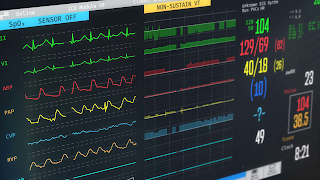3.15. SIM = simulation
Some days every patient I've ever had, including my mother and all the mannequins and simulations in skills lab, all blend together into one, genderless/all-gender, ageless patient with every disease process possible.
The patient needs mechanical ventilation to breathe, has a nasogastric tube and a gastric tube, a colostomy bag on the left abdomen, a urostomy bag on the right, has a central line in the jugular and in the femoral vein and four peripheral IV lines connecting to six different IV and drip pumps containing propofol & fentanyl (for sedation), insulin, two kinds of antibiotics, and fluids with potassium. Every line except for milky-white propofol is labeled and tagged to prevent confusion in the spectacular nest of tangled tubing that surrounds the bed.
The patient has a history of COPD, heart failure, type II diabetes, coronary heart disease, stroke, preterm labor, cancer, epileptic seizures, lower extremity amputation, hepatitis, liver and renal failure. The patient initially came in from home or a skilled nursing facility in respiratory distress, was involved in a traumatic car accident en route via ambulance, and has since been on every unit in the hospital.
The patient had a C-section, a natural birth, lost the baby, had a beautiful baby girl, developed full body infection, crashed, lost pulse, and diagnostic imaging showed a brain bleed, metastasized cancer, and necrotizing bowel obstruction. Fallopian tubes, uterus, gallbladder, appendix, one testicle, part of the colon and urinary tract were removed, with the gastro and urinary systems redirected to two separate, beefy-red stomas (openings) at the skin's surface. Also: thoracentesis to drain blood from the lungs, paracentesis to drain fluids in the abdomen, and part of the skull bone removed to allow the swelling brain some space to expand.
The entire interdisciplinary team has worked with this patient. Doctors of every flavor: gastrointestinal, obstetrics, oncology, nephrology, internal medicine, and palliative care. Respiratory therapists, lab technicians (dressed in red--patients call them vampires because they won't stop taking blood), speech therapists, physical therapists, surgeons, translators, volunteers, chaplains, case manager, social worker, registered nurses, certified nurse assistants, and every kind of student in the hospital.
The patient's family is both present and absent, and a full recovery or decline occurs. We never find out because we are just there for one shift at a time for one or two days. And no looking people up, either, because that's a HIPAA violation. No writing about specific patients except in our homework/paperwork with all identifiers removed, with only disease processes and interventions remaining.
Or perhaps like this, where everything is a huge, inseparable, mess. Every patient I've ever had haunts me, perhaps because I've learned so much from each of them.
The patient needs mechanical ventilation to breathe, has a nasogastric tube and a gastric tube, a colostomy bag on the left abdomen, a urostomy bag on the right, has a central line in the jugular and in the femoral vein and four peripheral IV lines connecting to six different IV and drip pumps containing propofol & fentanyl (for sedation), insulin, two kinds of antibiotics, and fluids with potassium. Every line except for milky-white propofol is labeled and tagged to prevent confusion in the spectacular nest of tangled tubing that surrounds the bed.
The patient has a history of COPD, heart failure, type II diabetes, coronary heart disease, stroke, preterm labor, cancer, epileptic seizures, lower extremity amputation, hepatitis, liver and renal failure. The patient initially came in from home or a skilled nursing facility in respiratory distress, was involved in a traumatic car accident en route via ambulance, and has since been on every unit in the hospital.
The patient had a C-section, a natural birth, lost the baby, had a beautiful baby girl, developed full body infection, crashed, lost pulse, and diagnostic imaging showed a brain bleed, metastasized cancer, and necrotizing bowel obstruction. Fallopian tubes, uterus, gallbladder, appendix, one testicle, part of the colon and urinary tract were removed, with the gastro and urinary systems redirected to two separate, beefy-red stomas (openings) at the skin's surface. Also: thoracentesis to drain blood from the lungs, paracentesis to drain fluids in the abdomen, and part of the skull bone removed to allow the swelling brain some space to expand.
The entire interdisciplinary team has worked with this patient. Doctors of every flavor: gastrointestinal, obstetrics, oncology, nephrology, internal medicine, and palliative care. Respiratory therapists, lab technicians (dressed in red--patients call them vampires because they won't stop taking blood), speech therapists, physical therapists, surgeons, translators, volunteers, chaplains, case manager, social worker, registered nurses, certified nurse assistants, and every kind of student in the hospital.
The patient's family is both present and absent, and a full recovery or decline occurs. We never find out because we are just there for one shift at a time for one or two days. And no looking people up, either, because that's a HIPAA violation. No writing about specific patients except in our homework/paperwork with all identifiers removed, with only disease processes and interventions remaining.
Or perhaps like this, where everything is a huge, inseparable, mess. Every patient I've ever had haunts me, perhaps because I've learned so much from each of them.



Comments
Post a Comment